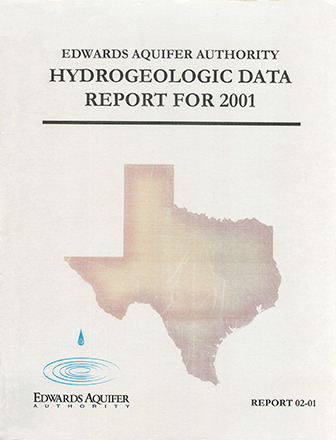Edwards Aquifer Authority Hydrogeologic Report for 2001

| Author | Johnson S, Esquilin R, Mahula DM, Thompson EL, Mireles J, Gloyd R, Sterzenback J, Hoyt JR and Schindel G |
| Year | 2002 |
| Description | Annual report for 2001 on recharge, discharge, water levels and water quality in the Edwards Aquifer San Antonio Region |
| Report Number | 02-01 |
| Publisher | Edwards Aquifer Authority |
| Location | Edwards Aquifer - San Antonio Area |
| Cover | View Download |
| File | View Download |
| Summary |
|
(Excerpted from the report Summary) Precipitation in the Edwards Aquifer region was generally above normal in 2001, especially in the spring and fall. … Water levels generally exceeded average levels in the Authority’s index wells in San Antonio, Hondo, and Uvalde. …During the summer, there was sufficient rainfall to recharge the aquifer and reduce demand, which moderated the typical seasonal decline of water levels for that time of year. Consequently, the Authority did not institute water use restrictions during the summer of 2001. Total recharge to the Edwards Aquifer was 1,069,400 acre-feet in 2001, approximately 50 percent above average. …Discharge from the Edwards Aquifer through springs and wells totaled 897,200 acre-feet, which also exceeded average values. … The water samples were analyzed for major ions, metals, TDS, hardness, and nutrients. Concentrations of major constituents are relatively uniform throughout the freshwater parts of the Edwards Aquifer. The freshwater portion of the aquifer consistently yields very hard, calcium bicarbonate water with low TDS and few detectable metals. It is generally of such high quality that it usually only requires chlorination to meet public drinking water standards. … Samples from two wells in the freshwater/saline water transect in San Marcos contained arsenic (LR-67-01-814A) and lead (LR-01-813A) concentrations above their MCLs…Like groundwater from the freshwater areas, water from springs and streams also contain low concentrations of TDS and few detectable metals. The water quality analyses also revealed organic chemicals in samples from two wells and two streams. Tetrachloroethene was detected at 7.6 μg/L in the sample from well YP-69-51-114 in Uvalde County. The source is an industrial dry cleaning operation that was destroyed by fire in 1979. … Tetrachloroethene has been detected in this well and other wells in Uvalde since 1983, and the TNRCC has an agreed order with the responsible party for investigation and cleanup. Tetrachloroethene also was detected at 0.57 μg/L in the sample from well AY-68-29-414 in Bexar County. The Authority and TNRCC are investigating the source. The herbicide, 2,4,5-T, was detected at 0.028 mg/L in the sample from the Hondo Creek at Tarpley on November 29, 2001. EPA banned this herbicide in 1970. Finally, pentachlorophenol was detected at 0.019 μg/L in the sample from Seco Creek at Miller Ranch collected on November 29, 2001. Pentachlorophenol is a wood preservative for utility poles, railroad ties, and other materials. Except for the tetrachloroethene detected in the Uvalde well, the concentrations of the organic compounds are below established levels for drinking water standards. The Authority will continue to monitor these locations to assess long-term data trends and investigate possible sources of the contaminants. Nitrate concentrations ranged from less than 0.01 mg/L to 4 mg/L in samples from most wells and streams in the Edwards Aquifer region. The concentration in only one sample (TD-69-31-603) exceeded the MCL (10 mg/L); the Authority is studying the trends of nitrate concentrations for evidence of contamination sources in the aquifer. The Authority continues its programs to protect the generally excellent water quality of the aquifer through investigating groundwater contamination and identifying and analyzing anomalous data from the Authority’s aquifer-wide sampling program. |
Search for Documents
Advance Search
Explore EAA's Scientific Reports
- All Reports
- Weather Modification
- Geology
- Water Use and Conservation
- Geochemistry
- Water Resources Planning and Management
- Floods and Drought
- Water Quality
- Climatology
- Surface Water / Groundwater Relationship
- Biology
- Springs, Groundwater Discharge
- Archaeology
- RZ Protection
- Aquifer Levels
- Remote Sensing
- Precipitation
- Overview Studies
- Modeling
- Hydrology and Hydrogeology
- History
- Groundwater Recharge, Recharge Zone
- Groundwater Movement
- Geomorphology and Caves
